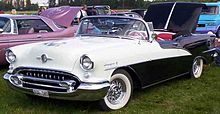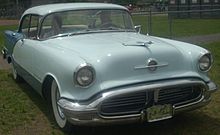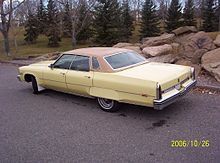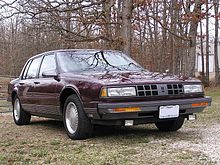- Oldsmobile 98
-
Oldsmobile Ninety-Eight 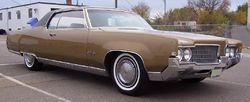
1969 Oldsmobile 98 Holiday CoupeManufacturer General Motors Also called Oldsmobile Custom Cruiser 98
Oldsmobile Futuramic 98Production 1941–1996 Predecessor Oldsmobile Custom Cruiser 90 Successor Oldsmobile Regency/LSS
Oldsmobile AuroraClass Full-size The Oldsmobile 98 (originally Series 90; a.k.a. Ninety-Eight) was a full-size automobile and the flagship model of the Oldsmobile division of General Motors. The name first appeared in 1941 and was used again after American consumer automobile production resumed post-World War II. It was, as it would remain, the top-of-the-line model, with lesser Oldsmobiles having lower numbers such as 66 and 76. These were replaced by the Oldsmobile 88 in 1949, and the two number-names would carry on into the 1990s as the bread and butter of the full-size Oldsmobile lineup until the Aurora would replace it for 1996.
General Motors developed a system of sharing body panels between models of its different makes, but the Ninety-Eight broke ranks several times with this system. Its second body makeover did not share body panels with the other senior makes, Buick and Cadillac. It did not even have its model-changeover synchronized with the same year as the Eighty-Eight in the mid-1950s.
Occasionally additional nomenclature was used with the name, such as L/S and Holiday, and the 98 Regency badge would become increasingly common in the later years of the model. The 98 shared its bodyshell with the Buick Electra.
As it was the top-line Oldsmobile, the series had the most technologically advanced items available, such as Twilight Sentinel (a feature that automatically turned the headlights on and off via a timer, as controlled by the driver), and the highest-grade interior and exterior trim.
First generation (1941–1947)
First generation 
1947 Oldsmobile Custom Cruiser 98 coupeModel years 1941–1942
1946-1947Body style 2-door coupe
4-door sedanLayout FR layout Wheelbase 1941-42:125.0 in (3,175 mm)[1]
1946-47: 127.0 in (3,226 mm)Length 216"[2] Naming standards were in flux at Oldsmobile during the late 1930s and 1940s. From 1932 through 1938 Oldsmobile had two series: "F" and "L". Series F came with a straight-6 engine and Series L came with a larger body and a straight-8 engine. Series F was renamed Series 60 in 1939 and Series L was replaced with the Series 70 and 80, with the Series 70 and 80 being powered by the straight-6 and the straight-8 respectively. In 1940 a larger body was introduced and it alone was powered by the straight-8. In order to differentiate it from the previous year's Series 80 it was named Series 90 (there was no Series 80 that year). The series were also given names for the first time that year with the Series 60, 70 and 90 being called the Special, Dynamic and Custom Cruiser respectively. In 1941 both engines were offered on each series so to differentiate between the two the second digit was used to denote the number of cylinders, so the Custom Cruiser 90 was replaced with the Custom Cruiser 96 and 98. In 1942 Oldsmobile dropped the six cylinder Series 90 model leaving only the Custom Cruiser 98. An electric clock was standard in 1947.[3]
Second generation (1948–1953)
Second generation 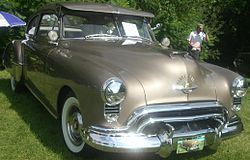
1949 Oldsmobile Futuramic 98 coupeModel years 1948–1953 Body style 2-door coupe
2-door Holiday hardtop
4-door sedan
4-door fastback Town Sedan
2-door convertibleLayout FR layout Engine 303.7 ci (5.0 L) V8 Wheelbase 122.0 in (3,099 mm)
124"(1953)[4]Length 215"[5] With the introduction of new postwar syling in 1948 the Custom Cruiser 98 was renamed the Futuramic 98. The following year the new styling was joined by a new engine, the now famous Rocket V8. In February 1949, several months into the model year, General Motors introduced three highly styled "hardtop convertible" coupes, the first of their type to be offered on a regular production basis (Chrysler had made seven prototype Town and Country hardtops in 1947). The Oldsmobile version, called Holiday, was exclusive to the 98 series that year. Available in four special Holiday colors, as well as four two-tone combinations, it was priced the same as the convertible, and was similarly equipped, with hydraulically operated windows and seat. In 1950, for one year only, Oldsmobile added a 4-door fastback to the lineup which they called Town Sedan. Also in 1950, Oldsmobile stopped naming the 98 series and so from then through 1996 it was simply known as the Oldsmobile 98. In 1953, a padded safety dash became optional on the 98 and standard on the 98 Fiesta.[5][6]
Third generation (1954–1956)
Third generation 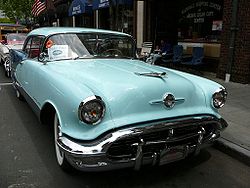
1954 Oldsmobile 98 Holiday coupeModel years 1954–1956 Body style 2-door coupe
2-door Holiday hardtop
4-door sedan
4-door fastback Town Sedan
2-door convertibleLayout FR layout Engine 303.7 ci (5.0 L) V8
324 ci (5.3 L) V8Wheelbase 126.0 in (3,200 mm) Length 214.3"[7] Width 78.3" In 1954, all Oldsmobile cars were redesinged. The 98 got the safety padded dash as standard.[5]
In 1955, the air conditioning unit was moved to the engine bay instead of the trunk.[8] The turning circle was 43ft.[9]
The 1956 98 had a 126 in (3,200 mm) wheelbase. It used a 324 in³ Rocket V8. The parking brake was now a foot pedal.[10]
Fourth generation (1957-1958)
Fourth generation 
1958 Oldsmobile 98 convertibleModel years 1957–1958 Body style 2-door coupe
4-door sedan
2-door convertibleLayout FR layout Engine 324 ci (5.3 L) V8
371 ci (6.1 L) V8
394 ci (6.5 L) V8Wheelbase 126.5 in (3,213 mm) Length 216.7"[11] Width 76.38"[12] In 1957, Oldsmobile added a safety recessed steering wheel.[13] The 98 was renames Starfire 98.[14] Power windows were standard.[15]Front leg room was 43.8 inches.[16]
In 1958, Oldsmobile added air suspension as an option.[17] Also new was a speed warning device.[18]
That engine was replaced by a 371 in³ engine for 1957 until the 371 was dropped in 1961.[19]Fifth generation (1959–1960)
Fifth generation Model years 1959-1960 Body style 2-door hardtop
2-door convertible
4-door sedan
4-door hardtopLayout FR layout Platform C-body Engine 394 cu in (6.5 L) V8 Wheelbase 126.3 in (3,208 mm) Length 223"[20] Related Cadillac Deville
Cadillac Series 62
Buick ElectraDesigner Bill Mitchell In 1959, the Oldsmobile line-up was redesinged. However, unlike other GM makes(such as Chevrolet and Cadillac[21]) Oldsmobile continued to use a full perimiter frame, instead of the GM X-frame.[22]
In 1960, an anti spin rear axle was optional.[23]
The 394, the largest first-generation Rocket V8, was used from 1959 until 1964.
Sixth generation (1961–1964)
Sixth generation Model years 1961-1964 Body style 2-door hardtop
2-door convertible
4-door sedan
4-door hardtopLayout FR layout Platform C-body Wheelbase 126.0 in (3,200 mm) Related Cadillac Deville
Cadillac Series 62
Buick ElectraDesigner Bill Mitchell For 1961 only, it was renamed Classic 98; nevertheless, "most factory literature refers to the line as the Ninety-Eight."[19] Malcolm X owned a 1963 Oldsmobile 98—black, 4 door, hardtop—and it can be seen in the lobby of the Malcolm X College on the south side of Chicago.
Seventh generation (1965–1970)
Seventh generation 
1965 Oldsmobile 98Model years 1965–1970 Body style 2-door coupe
4-door sedan
2-door convertibleLayout FR layout Platform GM C platform Engine 425 in³ (7.0 L) Super Rocket V8
455 in³ (7.4 L) Rocket V8Transmission 3-speed manual
3-speed automaticWheelbase 1965-68: 126.0 in
1969-70: 127.0 in.Length 224.4 in (5,700 mm) Width 80.0 in (2,032 mm) Height 54.8 in (1,392 mm) Related Buick Electra The 1965 Ninety-Eight received an all-new bodyshell along with other full-sized Oldsmobiles but retained a larger C-body shared with Cadillac in contrast with the B-body used in the Oldsmobile 88. The Ninety-Eight featured many of the lines found on 88s but with more squared off styling. Also new for 1965 was the Ninety-Eight Luxury Sedan, which featured an even more luxurious interior along with more standard amenities than the regular Ninety-Eight models such as power windows and seats. Most 98 LS's also had vinyl roofs, which were offered only in black that year. A new three-speed Turbo Hydra-Matic automatic transmission with torque converter replaced the Roto Hydramatic (Slim-Jim)that Olds had been using since 1961. Along with the transmission and bodyshell, the engine was also new for 1965. It was a 425 cubic-inch Super Rocket V8 that was more powerful and of a more efficient design than the older 394 cubic-inch V8 previously used, yet it was much lighter in weight. The Ninety-Eight's standard and only engine offering for 1965 was the four-barrel "Ultra High Compression" version of the 425 Super Rocket rated at 360 horsepower (270 kW). It was the last Oldsmobile 98 generation with a manual transmission.
1969
With a 127 inch (10.6 feet) wheelbase, length of 224.4 inches (18.7 feet), width of 80.0 inches (6.7 feet), a height of 54.8 inches (4.5 feet), and a weight of 4,168 lbs. (2.084 tons), the Ninety-Eight's continued to be the largest models produced by Oldsmobile.
New to the Ninety-Eight series were a recessed padded instrument panel, anti-theft lock within the steering column, rear view mirror map light, mini-buckle seat belts, and deeply padded head restraints.
Standard for the Ninety-Eight's was the 365-HP 455 Rocket V-8 (7.5 liters) which required premium leaded gas; Turbo Hydra-Matic 400 transmission, power steering (vari-ratio), power brakes, power windows, power seat, custom sport seat, foam padded front seat, deluxe steering wheel, self regulating electric clock, and wheel discs (hub caps).
Some of the available options were a tilt-telescope steering wheel, instant horn, four season air conditioning with comfortron, tinted glass windshield, 6 way power seat, divided front seat with dual controls, power trunk release (vacuum), power control (power windows & power locks), power front disc brakes, am-fm stereo radio, rear seat speaker, stereo tape player (8-track), power operated antenna, door edge guards, cruise control, left outside remote control mirror, cornering lamps, anti-spin rear axle, vinyl roof, flo-thru ventilation, and safety sentinel.
Of the Ninety-Eight series, the 1969's were the only models to have an attached hood extension. After receiving numerous complaints from dealership mechanics about hitting their heads on the extension, Oldsmobile changed the style of the hood in 1970, removing the extension, which resulted in a flat hood design.
Between 1965 and 1975 Oldsmobile commissioned Cotner-Bevington to build professional cars, (ambulances and hearses), using the large Ninety-Eight chassis. Ironically, during the '60's (1968), the only Oldsmobile professionally made into a limousine was the smaller Toronado, known as the AQC Jetway 707.
In 1970, the length grew to 225.2 inches.[24]
Eighth generation (1971-1976)
Eighth generation 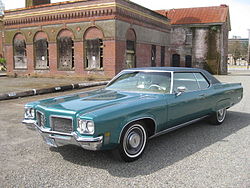
1971 Oldsmobile 98 coupeModel years 1971–1976 Assembly Lansing, Michigan, USA
Linden, New Jersey, USABody style 2-door hardtop
2-door coupe
4-door hardtopLayout FR layout Platform C-body Engine 455 cu in (7.5 L) Rocket V8 Transmission 3-speed TH-400, automatic Wheelbase 127.0 in (3,226 mm) Length 1971: 226.1 in (5,743 mm)
1972: 227.8 in (5,786 mm)
1973: 230.3 in (5,850 mm)
1974–76: 232.2 in (5,898 mm)Width 1971: 79.0 in (2,007 mm)
1972-73: 79.6 in (2,022 mm)
1974-75: 79.8 in (2,027 mm)
1976: 80.0 in (2,032 mm)Height 1971-72: 54.6 in (1,387 mm)
1973: 54.7 in (1,389 mm)
1974-75: 54.2 in (1,377 mm)
1976: 54.7 in (1,389 mm)Curb weight 4,700–5,200 lb (2,100–2,400 kg) Related Cadillac Deville
Cadillac Calais
Buick Electra
Buick Estate
Oldsmobile Custom Cruiser
Pontiac Grand SafariDesigner Bill Mitchell Oldsmobile built its biggest full-size car in 1971 although wheelbase was unchanged from 1970. The 1971 through 1976 Ninety-Eight was very similar to the Oldsmobile 88 (which by now was called the "Delta 88") except the Ninety-Eight had rear Cadillac-esque tailfins to differentiate between the two full-size models. The standard 455 cubic-inch Rocket V8 was rated at 340 hp (254 kW) and designed to run on lower octane regular lead, low-lead or unleaded gasoline for the first time this year thanks to a General Motors-mandate that all engines be designed to run on such fuels in preparation for the catalytic converter equipped cars of 1975 and later years that absolutely required unleaded gasoline.
Despite this, a few 1975 and 1976 Ninety Eights were released from this catalytic converter requirement in Canada and were given certification along with exemption from requiring unleaded gasoline. V8's were progressively detuned as production wore on in line with tighter emission standards.
A new bodyshell was introduced this year that would last until the 1976 model year. They were the biggest and heaviest Oldsmobiles ever built, specifically the 1974 to 1976 models when federally mandated 5 mph (8.0 km/h) bumpers were added both front and rear that increased the overall length of the cars by several inches to 232.2 (5898 mm)
Trunk mounted louvers for the flow through ventilation system were only found on 1971 models (as in many other GM models of 1971). The louvers were moved to the door jambs for 1972-1976 models.
The 1974-76 Oldsmobile Ninety-Eight (as well as the 74-76 Olds Delta 88, Olds Toronado, Buick LeSabre and Buick Electra Park Avenue) were among the first US production cars to offer an air bag option beginning in 1974. Very few cars were so equipped. The high cost ($700) plus public uncertainty about the yet-to-be proven safety systems that are now universal in today's automobiles saw quite handily to that.
Ninety Eight Regency
For the 1972 model year, the Limited Edition Regency was offered to commemorate Oldsmobile's 75th anniversary. Each 1972 Oldsmobile Ninety-Eight Regency was registered at Tiffany's and included the specially styled interior with a black or covert "pillow effect" velour upholstery, and power split bench seat, in place of the power bench seat with rear clock. Tiffany touches include the Tiffany Gold paint (an exclusive custom metallic color created especially for this car), the clock has also been specially styled by Tiffany's and bears a white Oldsmobile emblem above the Tiffany's name on a golden face. Each 1972 Regency owner received a distinctive sterling silver key ring as a gift, if ever lost the keys could be dropped in a mail box, and Tiffany's would return them to the owner. A total of 2650 75th anniversary Ninety-Eight Regencys were built, all of them 4 door hardtops. In 1973 the non-anniversary Regency stayed in the line up slotted just above the LS. The Regency package would remain available on the Ninety Eight throughout the 1996 model year when it would become a separate model nameplate.
Ninth generation (1977–1984)
Ninth generation 
1978 Oldsmobile 98 RegencyModel years 1977–1984 Assembly Lansing, Michigan, United States
Linden, New Jersey, United StatesBody style 2-door coupe
4-door sedanLayout FR layout Platform GM C platform Engine 252 in³ (4.1 L) Buick V6
307 in³ (5.0 L) Oldsmobile V8
350 in³ (5.7 L) Oldsmobile V8
350 in³ (5.7 L) Oldsmobile diesel V8
403 in³ (6.6 L) Oldsmobile V8Transmission 3-speed TH350 automatic
3-speed TH400 automatic
4-speed THM 200-4R automaticWheelbase 119.0 in (3,023 mm) Length 221.4 in (5,624 mm) Width 76.3 in (1,938 mm) Height 55.3 in (1,405 mm) Related Buick Electra The 1977 model was extensively redone and downsized, at the same time as the Oldsmobile 88. The new models, at around 4000 pounds curb weight, were over 800 pounds lighter, but headroom and rear seat legroom were increased compared to equivalent 1976 models. The 455 in³ engine was replaced by the smaller 403 in³ V8. The Olds 350 was now standard. A diesel version of the 350 was added in 1978. Beginning in 1979, production of the 98 was exclusive to Lansing as Linden Assembly was retooled to build the E-body cars.
Size comparison between 1974 and 1977 Oldsmobile 98
1974 Oldsmobile 98 1977 Oldsmobile 98 Wheelbase 127.0 in (3,226 mm) 119.0 in (3,023 mm) Overall Length 232.2 in (5,898 mm) 220.4 in (5,598 mm) Width 79.8 in (2,027 mm) 76.8 in (1,951 mm) Height 54.2 in (1,377 mm) 56.6 in (1,438 mm) Front Headroom 39.3 in (998 mm) 39.3 in (998 mm) Front Legroom 42.2 in (1,072 mm) 42.2 in (1,072 mm) Front Hip Room 62.3 in (1,582 mm) 55.0 in (1,397 mm) Front Shoulder Room 64.3 in (1,633 mm) 60.6 in (1,539 mm) Rear Headroom 38.2 in (970 mm) 38.0 in (965 mm) Rear Legroom–ins. 40.8 in (1,036 mm) 40.9 in (1,039 mm) Rear Hip Room 62.8 in (1,595 mm) 55.7 in (1,415 mm) Rear Shoulder Room 63.4 in (1,610 mm) 60.6 in (1,539 mm) Luggage Capacity 22.3 cu ft (631 L) 20.3 cu ft (575 L) Base LS models were available as sedans only, and the premium Regency model came as either a coupe or a sedan. 1981 saw the introduction of Buick's 252 in³ V6 as standard, as well as a new 4-speed THM200-4R automatic transmission. The new Regency Brougham model was introduced for 1982. This car featured plush "Prima" velour seats with embroidered emblems, cut pile carpeting, and electroluminescent opera lamps on the B-pillars. The LS model was discontinued. The 1983 models received a new grille, but were otherwise unchanged. The federal 5 mph (8.0 km/h) impact standard was rolled back for 1984, prompting GM to make major changes to the bumpers to save weight; predictably, this drastically reduced their effectiveness. An 8-track tape player was no longer an option.
Production ended in March 1984. These cars were actually sold concurrently with the new front-wheel drive 1985 model.[25] The body style reference in GM Manufacturing became "D" for the carryover RWD models, and the new FWD cars became C-bodies (as was the former designation for the RWD cars).
Tenth generation (1985–1990)
Tenth generation 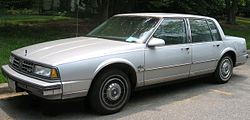
1987 Oldsmobile 98 sedanModel years 1985–1990 Assembly Wentzville, Missouri, United States
Lake Orion, Michigan, United StatesBody style 2-door coupe
4-door sedanLayout FF layout Platform GM C platform Engine 3.0 L Buick V6
3.8 L Buick V6Transmission 4-speed automatic Wheelbase 110.8 in (2,814 mm) Length 1987–88: 196.4 in (4,989 mm)
1989–1990: 196.3 in (4,986 mm)Width 1987–88: 72.4 in (1,839 mm)
1989–1990: 72.6 in (1,844 mm)Height 1987–88: 55.1 in (1,400 mm)
1989–1990: 54.8 in (1,392 mm)Related Buick Electra
Cadillac DeVille
Cadillac Fleetwood1985 saw the Ninety-Eight downsized for a second time, this time switching from rear-wheel drive to a new front-wheel drive platform, with sales beginning in April 1984.[25] Although this Ninety-Eight was nearly 25.0 in (635 mm) shorter in length and weighed over 700 lb (318 kg) less than its predecessor,[26] passenger space was nearly equal to 1984 models. Buyers seemed to prefer this new, more manageable Ninety-Eight, as 1985 model year sales, at 169,432 units, were more than double 1984's 76,833 units.[27]
Size comparison between 1984 and 1985 Oldsmobile 98 [26]
1984 Oldsmobile Ninety-Eight Regency Brougham sedan 1985 Oldsmobile Ninety-Eight Regency Brougham sedan Wheelbase 119.0 in (3,023 mm) 110.8 in (2,814 mm) Overall Length 221.1 in (5,616 mm) 196.4 in (4,989 mm) Width 76.3 in (1,938 mm) 71.4 in (1,814 mm) Height 58.0 in (1,473 mm) 56.0 in (1,422 mm) Curb Weight 4,024 lb (1,825 kg) 3,292 lb (1,493 kg) Front Headroom 39.5 in (1,003 mm) 39.3 in (998 mm) Front Legroom 42.2 in (1,072 mm) 42.4 in (1,077 mm) Front Shoulder Room 59.6 in (1,514 mm) 58.9 in (1,496 mm) Rear Headroom 38.1 in (968 mm) 38.1 in (968 mm) Rear Legroom 41.7 in (1,059 mm) 40.8 in (1,036 mm) Rear Shoulder Room 59.8 in (1,519 mm) 58.8 in (1,494 mm) Luggage Capacity 20.5 cu ft (580 L) 15.7 cu ft (445 L) As in previous years, the 1985 Ninety-Eight was available as a 4-door sedan and a 2-door coupe, in either Regency or Regency Brougham trim. Both models came with standard velour seating, with Sierra grain leather optional on both.[28] For the first year, the Buick 181 in³ V6 was the standard powerplant. V8 engines were gone for good, never to return to the Ninety-Eight. Optional engines were Buick's 231 and Oldsmobile's 263 in³ diesel V6. The 3.0 gas V6 and 4.3 diesel V6 were dropped for 1986.
Oldsmobile consistently improved this generation Ninety-Eight over its six-year run, treating it to yearly updates. A special "Grande" package was offered in 1986 and 1987 only, featuring composite headlights and specific front end panel (1986 only), and 45/45 leather seats with pigskin inserts and console with combination lock. For 1987, all Ninety-Eights received a new grille with flush composite headlamps. The performance-oriented Touring Sedan model was also introduced this year.[29] It consisted of leather seats designed by Lear Jet company, and onboard computer (1988-1990 only), FE3 sport suspension, self closing trunk, burled walnut interior, console shifter, and 16 inch alloy wheels (1988 and up years)(1987 featured 15 inch alloy wheels). 1988 saw the discontinuation of the slow-selling 2-door coupe body style. For the 1989 model year, the Ninety-Eight saw another grille change and the addition of an optional driver's-side airbag. The number of Oldsmobile Ninety-Eight's ordered with an airbag are rare. Keyless entry was available for 1990. By 1990, its final model year, the tenth-generation Oldsmobile Ninety-Eight was peaking in terms of mechanic perfection. It had a new harmonic balancer and increased horsepower from the somewhat sluggish 1985 models. Other interesting features on the 1990 included Twilight Sentinel headlights, as well as an on-board computer with an oil life monitor. It was called the Driver Information System.
Engines:
Year Engine Power Torque 1985 3.0 L Buick V6 110 hp (82 kW) at 4800 rpm 145 lb·ft (197 N·m) at 2600 rpm 1985 3.8 L Buick MPFI V6 125 hp (93 kW) at 4400 rpm 195 lb·ft (264 N·m) at 2000 rpm 1985 4.3 L Oldsmobile Diesel V6 85 hp (63 kW) 165 lb·ft (224 N·m) 1986 3.8 L Buick SFI V6 140 hp (104 kW) at 4400 rpm 200 lb·ft (270 N·m) at 2000 rpm 1987 150 hp (112 kW) at 4400 rpm 200 lb·ft (270 N·m) at 2000 rpm 1988 160 hp (119 kW) at 5200 rpm 1990 3.8 L Buick LN3 V6 165 hp (123 kW) at 5200 rpm 210 lb·ft (285 N·m) at 2000 rpm Eleventh generation (1991–1996)
Eleventh generation 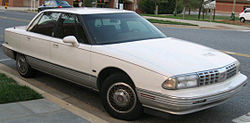
1991-1996 Oldsmobile 98Model years 1991–1996 Assembly Lake Orion, Michigan, United States Body style 4-door sedan Layout FF layout Platform GM C platform Engine 3.8 L Buick V6 Transmission 4-speed automatic Wheelbase 110.8 in (2,814 mm) Length 205.7 in (5,225 mm)
1991–93 Touring: 205.8 in (5,227 mm)Width 74.6 in (1,895 mm) Height 54.8 in (1,392 mm) Related Buick Park Avenue
Cadillac DeVille
Cadillac FleetwoodThe final redesigned generation of the Oldsmobile Ninety-Eight coincided with its 50th anniversary in 1991. The added length, rear fender skirts, wide tail, low nose, and split-grille with wraparound headlights gave this generation Ninety-Eight a far more distinctive appearance than its predecessor. Designers of the Ninety-Eight wanted to create a distinctive luxury car look that buyers would not confuse with a similar Buick or Pontiac sedan.[30] The final generation of the Ninety-Eight would also prove to be the shortest, seeing its last year in 1996.
Although wheelbase was unchanged from the previous generation, overall length increased by over 9 inches (229 mm).[31] Most of this extra space was added to the rear of the car, resulting in a larger trunk. Although throughout the model years names of the trim levels changed, the final generation Ninety-Eight was available in two main models: the traditional luxury-oriented Regency models and the performance-oriented Touring models. Regency models included 6-passenger seating in either velour or leather, column shifter, and the 170 horsepower (130 kW) 3.8 L Buick V6. Touring models featured the FE3 suspension package, a 205 hp (upped to 225 hp in 1994) supercharged version of the standard 3.8 L Buick V6, 18 gallon fuel tank, 16-inch wheels, and standard 5-passenger leather seating designed by Lear Seating.
With the introduction of the Aurora a year earlier, the Ninety-Eight was discontinued for 1996, ending production on May 31.[32] To fill the void, two Eighty-Eight relatives – the Regency and the LSS – were introduced. The sporty LSS featured the steel front fenders, while the more stately and traditional Regency 88's had the carryover GTX-composite (plastic) fenders from the 1996 Ninety Eight. The LSS model proved more popular to buyers than the Regency during the 1997-98 model years.
Engines:
- 1991–1996 3.8 L (231 in³) V6
- 1992–1995 3.8 L (231 in³) supercharged V6
Trim Levels:
- Regency Elite - 1991–1996
- Touring - 1991–1993
- Regency - 1992–1994
- Touring Supercharged - 1992–1993
- Regency Special - 1993–1994
- Regency Supercharged - 1994
- Regency Elite Supercharged - 1995
References
- ^ http://www.oldcarbrochures.com/static/NA/Oldsmobile/1941_Oldsmobile/1941_Oldsmobile_Prestige_Brochure/1941%20Oldsmobile%20Prestige-30-31.html
- ^ Flory, Jr., J. "Kelly" (2008). American Cars, 1946-1959 Every Model Every Year. McFarland & Company, Inc., Publishers. ISBN 978-0-7864-3229-5.
- ^ Flory, Jr., J. "Kelly" (2008). American Cars, 1946-1959 Every Model Every Year. McFarland & Company, Inc., Publishers. ISBN 978-0-7864-3229-5.
- ^ "Directory Index: Oldsmobile/1953 Oldsmobile/album". Oldcarbrochures.com. http://www.oldcarbrochures.com/static/NA/Oldsmobile/1953%20Oldsmobile/album/1953%20Oldsmobile-24.html. Retrieved 2011-11-09.
- ^ a b c Flory, Jr., J. "Kelly" (2008). American Cars, 1946-1959 Every Model Every Year. McFarland & Company, Inc., Publishers. ISBN 978-0-7864-3229-5.
- ^ "Directory Index: Oldsmobile/1953 Oldsmobile/album". Oldcarbrochures.com. http://www.oldcarbrochures.com/static/NA/Oldsmobile/1953%20Oldsmobile/album/1953%20Oldsmobile-10.html. Retrieved 2011-11-09.
- ^ Flory, Jr., J. "Kelly" (2008). American Cars, 1946-1959 Every Model Every Year. McFarland & Company, Inc., Publishers. ISBN 978-0-7864-3229-5.
- ^ http://www.oldcarbrochures.com/static/NA/Oldsmobile/1955%20Oldsmobile/1955_Oldsmobile_Brochure/1955%20Oldsmobile-30-31.html
- ^ http://www.oldcarbrochures.com/static/NA/Oldsmobile/1955%20Oldsmobile/1955_Oldsmobile_Brochure/1955%20Oldsmobile-32.html
- ^ http://www.oldcarbrochures.com/static/NA/Oldsmobile/1956%20Oldsmobile/album/1956%20Oldsmobile-14.html
- ^ http://www.oldcarbrochures.com/static/NA/Oldsmobile/1957%20Oldsmobile/album/1957%20Oldsmobile-16.html
- ^ http://www.oldcarbrochures.com/static/NA/Oldsmobile/1957%20Oldsmobile/album/1957%20Oldsmobile-16.html
- ^ http://www.oldcarbrochures.com/static/NA/Oldsmobile/1957%20Oldsmobile/album/1957%20Oldsmobile-15.html
- ^ http://www.oldcarbrochures.com/static/NA/Oldsmobile/1957%20Oldsmobile/album/1957%20Oldsmobile-10.html
- ^ Flory, Jr., J. "Kelly" (2008). American Cars, 1946-1959 Every Model Every Year. McFarland & Company, Inc., Publishers. ISBN 978-0-7864-3229-5.
- ^ Flory, Jr., J. "Kelly" (2008). American Cars, 1946-1959 Every Model Every Year. McFarland & Company, Inc., Publishers. ISBN 978-0-7864-3229-5.
- ^ http://www.oldcarbrochures.com/static/NA/Oldsmobile/1958_Oldsmobile/1958_Oldsmobile_Brochure/1958%20Oldsmobile-24-25.html
- ^ http://www.oldcarbrochures.com/static/NA/Oldsmobile/1958_Oldsmobile/1958_Oldsmobile_Brochure/1958%20Oldsmobile-28-29.html
- ^ a b Flory, J. "Kelly", Jr. American Cars 1960-1972 (Jefferson, NC: McFarland & Coy, 2004), p.118.
- ^ http://www.oldcarbrochures.com/static/NA/Oldsmobile/1959%20Oldsmobile/album/1959%20Oldsmobile-30-31.html
- ^ http://www.oldcarbrochures.com/static/NA/Cadillac/1959_Cadillac/1959_Cadillac_Brochure/1959%20Cadillac-15.html
- ^ http://www.oldcarbrochures.com/static/NA/Oldsmobile/1959%20Oldsmobile/album/1959%20Oldsmobile-26-27.html
- ^ http://www.oldcarbrochures.com/static/NA/Oldsmobile/1960%20Oldsmobile/1960%20Oldsmobile%20Brochure/1960%20Oldsmobile-26-27.html
- ^ http://www.oldcarbrochures.com/static/NA/Oldsmobile/1970%20Oldsmobile/1970_Oldsmobile_Prestige_Brochure/1970%20Oldsmobile%20Prestige-48.html
- ^ a b Stark, Harry A (February 1984). "C-car conundrum: selling two different cars with one name". Ward's Auto World. http://www.findarticles.com/p/articles/mi_m3165/is_v20/ai_3121734. Retrieved 2007-04-01.
- ^ a b Oldsmobile Sales Material "1985 Oldsmobile Ninety-Eight Regency Marketing Guide", authorized by General Motors Corporation
- ^ Encyclopedia of American Cars "Oldsmobile" p.663: "Oldsmobile Production Figures."
- ^ Oldsmobile Sales Material "1985 Oldsmobile Ninety-Eight Sales Brochure", authorized by General Motors Corporation
- ^ Oldsmobile Sales Material "1987 Oldsmobile Line Sales Brochure, Vol. I", authorized by General Motors Corporation
- ^ "MW 1991 Oldsmobile Ninety Eight Touring Sedan Road Test". Youtube. http://www.youtube.com/watch?v=Cok3qfkNLNI. Retrieved 2010-05-17.
- ^ "How Oldsmobile Cars Work: 1991, 1992, 1993, 1994, 1995 Oldsmobile Cars" by the Auto Editors of Consumer Guide, retrieved on 2010–05–17.
- ^ Ward's Automotive Yearbook 1997. Ward's Communications, Inc. 1997.
External links
- '82 Sedan
- The '80's Olds 98 Page
- Check out our build-up of a 1956 Olds 98
- Oldsmobile Ads from the Forties to the Sixties
- The Oldsmobile Connection - The Site For Oldsmobile Enthusiasts
- Cotner-Bevington built professional cars using the Ninety-Eight chassis
Cars 40 • 53 • 66 • 88 • 98 • 442 • Achieva • Alero • Aurora • Curved Dash • Custom Cruiser • Cutlass • Cutlass Calais • Cutlass Ciera • Cutlass Cruiser • Cutlass Supreme • F-85 • Firenza • Intrigue • Jetstar I • Limited Touring • Omega • Series 60 • Series 70 • Oldsmobile Series 90 • Starfire • Toronado • Vista CruiserMinivans / SUVs Concepts and Prototypes F-88 (1954) • Golden Rocket (1956) • Aerotech I (1987) • Aerotech II (1989) • Tube Car (1989) • Aerotech III (1989) • Expression (1990) • Antares (1995) • Alero Alpha (1997) • Recon (1999) • Profile (2000) • O4 (2001)Oldsmobile road car timeline, Post WW2–1970s — next » Type 1940s 1950s 1960s 1970s 6 7 8 9 0 1 2 3 4 5 6 7 8 9 0 1 2 3 4 5 6 7 8 9 0 1 2 3 4 5 6 7 8 9 Subcompact Starfire Compact F-85 Omega Mid-size 66/68 F-85 F-85 Vista Cruiser Vista Cruiser Vista Cruiser Cutlass Cruiser 76/78 Cutlass Cutlass Cutlass Cutlass Full-size 88 88 88 88 88 88 88 88 98 98 98 98 98 98 98 98 98 Custom Cruiser Custom Cruiser Personal luxury Toronado Toronado Toronado « previous — Oldsmobile road car timeline, 1980s–2004 Type 1980s 1990s 2000s 0 1 2 3 4 5 6 7 8 9 0 1 2 3 4 5 6 7 8 9 0 1 2 3 4 Compact Starfire Firenza Omega Cutlass Calais Achieva Alero Mid-size Cutlass Cutlass Ciera Cutlass Cutlass Cruiser Cutlass Cruiser Cutlass Supreme Cutlass Supreme Intrigue Full-size Eighty-Eight Eighty-Eight Eighty-Eight Ninety-Eight Ninety-Eight Ninety-Eight Regency Custom Cruiser Custom Cruiser LSS Aurora Aurora Personal luxury Toronado Toronado Minivan Silhouette Silhouette SUV Bravada Bravada Bravada Categories:- Oldsmobile vehicles
- Front wheel drive vehicles
- Full-size vehicles
- Rear wheel drive vehicles
- 1940s automobiles
- 1950s automobiles
- 1960s automobiles
- 1970s automobiles
- 1980s automobiles
- 1990s automobiles
Wikimedia Foundation. 2010.



